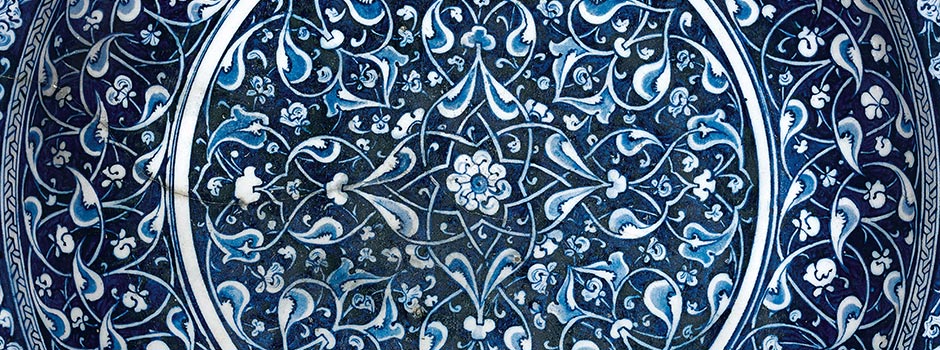
LEADING ARTS OF THE ISLAMIC WORLD SALE AT SOTHEBY’S LONDON (OCT 24, 2018) Exceptionally Rare Museum-Quality Charger (c.1480) – Created at the Genesis of Iznik Pottery
Oct 20, 2018 Art Auction

-Sothebys.jpg) A highly important blue and white Iznik pottery charger, Turkey, circa 1480 (1) / © Sotheby's
A highly important blue and white Iznik pottery charger, Turkey, circa 1480 (1) / © Sotheby's
One of the most important pieces of Iznik pottery remaining in private hands, this large and intact dish, or charger, represents a significant discovery in the field of Ottoman art. It belongs to the earliest group of Iznik – produced at the very advent of the art form during the reign of Mehmet II (‘the Conqueror’) – the finest examples of which are almost all held in museum collections across the globe. This small, and exceptionally rare, group of Iznik pottery is characterised by an intense, inky, blue-black colouring, which reflects the embryonic stage of firing control – roughly two decades before a brighter cobalt blue was accomplished. This special piece encapsulates a symbiosis of influences, both local and foreign, as well as a flair for invention.
The ‘Debbane Charger’ is a lost sibling to four other large dishes, all of which are held in museum collections – including Paris’ Musée du Louvre – and are published in Nurhan Atasoy and Julian Raby’s landmark book Iznik: The Pottery of Ottoman Turkey in 1989, where it was suggested that they were used in banquets at the Court for large quantities of food. Though not identical, they display a number of shared elements – the huge scale, central floret, and use of both Rumi and Hatayi motifs, the names given to the rigorously executed arabesque decoration and Chinoiserie floral scrolls respectively. Sotheby’s sale catalogue is the first time that this discovered counterpart has been published.
The charger was formerly in the collection of prolific bibliophile and businessman Max Debbane (1893-1965), who patronised many leading cultural institutions in the town of his birth, Alexandria, as well as serving as President of the Archaeological Society. Opportunities to acquire works of Iznik pottery from this earliest period are indescribably rare, with the most significant examples dating back to Sotheby’s sales in 1993 and 1997.
Mehmet II was renowned for his intense interest in and patronage of the arts and architecture, and is celebrated for inviting foreign artists to his royal court. Exquisite Iznik pieces such as the ‘Debbane Charger’ could only have been born out of demand from the court itself, since only royalty could finance such an industry dictated by its exacting tastes. Aside from the Islamic arts of illumination and calligraphy, the decoration of this piece owes a debt to two other distinct influences – Chinese porcelain and Islamic metalwork. This group of five chargers is exactly the size of Yuan porcelain dishes, which were amongst the popular blue and white wares imported into the Ottoman Empire. The influence of Balkan silver bowls is also evident, as the laborious reserved decoration attempts to create the impression of relief metalwork.
 An Iznik pottery rimless ‘grape’ dish, Turkey, circa 1570-80 / Courtesy of Sotheby's
An Iznik pottery rimless ‘grape’ dish, Turkey, circa 1570-80 / Courtesy of Sotheby's
Iznik grape dishes tell an interesting story about the cross-cultural pollination between Chinese and Ottoman art. Yuan and Ming Dynasty blue and white porcelain became particularly desirable at the Ottoman court, with important examples in the Topkapi Palace inspiring craftsmen to produce variations of the popular model. This boldly decorated and lively piece belongs to the second wave of grape dish design, in which the potters seem to emancipate themselves, removing the breaking-wave border and introducing a new colour – deep green.
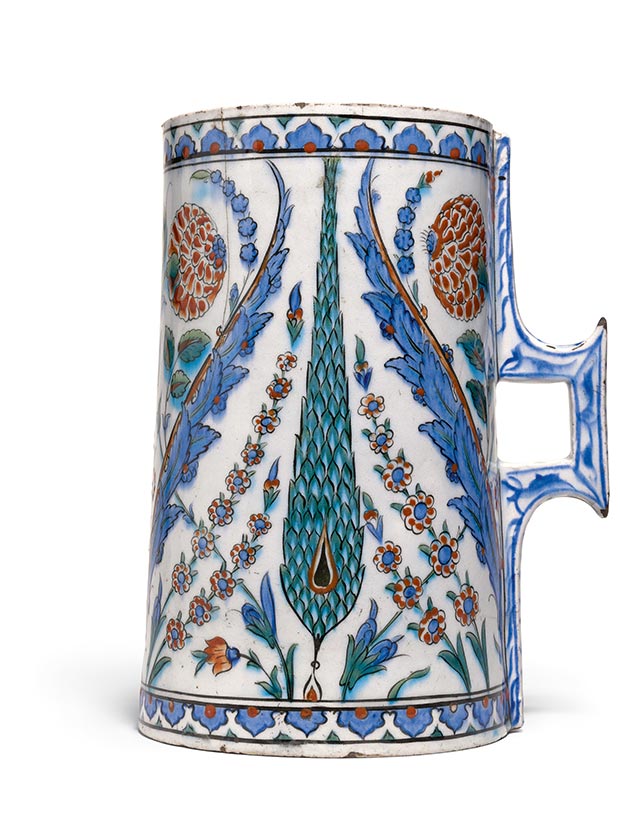 A monumental Iznik polychrome pottery tankard, Turkey, circa 1575-80 (est. £50,000-70,000) / Courtesy of Sotheby's
A monumental Iznik polychrome pottery tankard, Turkey, circa 1575-80 (est. £50,000-70,000) / Courtesy of Sotheby's
At almost 28 centimetres in height, this is an extremely rare model of an over-sized tankard, with most known examples measuring in the region of twenty to twenty-three centimetres. Derived from a European form typically constructed in leather or carved from wood, the tankard form was produced towards the end of the Ottoman era in both ceramic and metal.
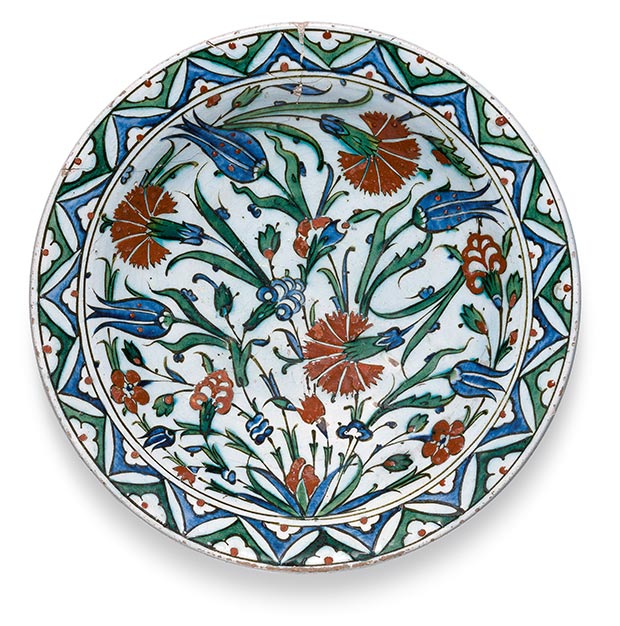 A large Iznik polychrome pottery dish with floral border, Turkey, circa 1580-85 / Courtesy of Sotheby's
A large Iznik polychrome pottery dish with floral border, Turkey, circa 1580-85 / Courtesy of Sotheby's
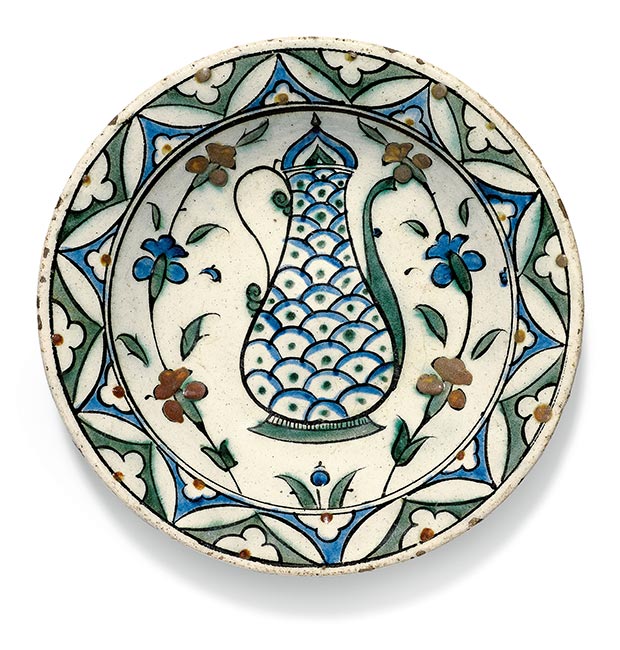 An Iznik polychrome pottery dish with ewer, Turkey, 17th century / Courtesy of Sotheby's
An Iznik polychrome pottery dish with ewer, Turkey, 17th century / Courtesy of Sotheby's
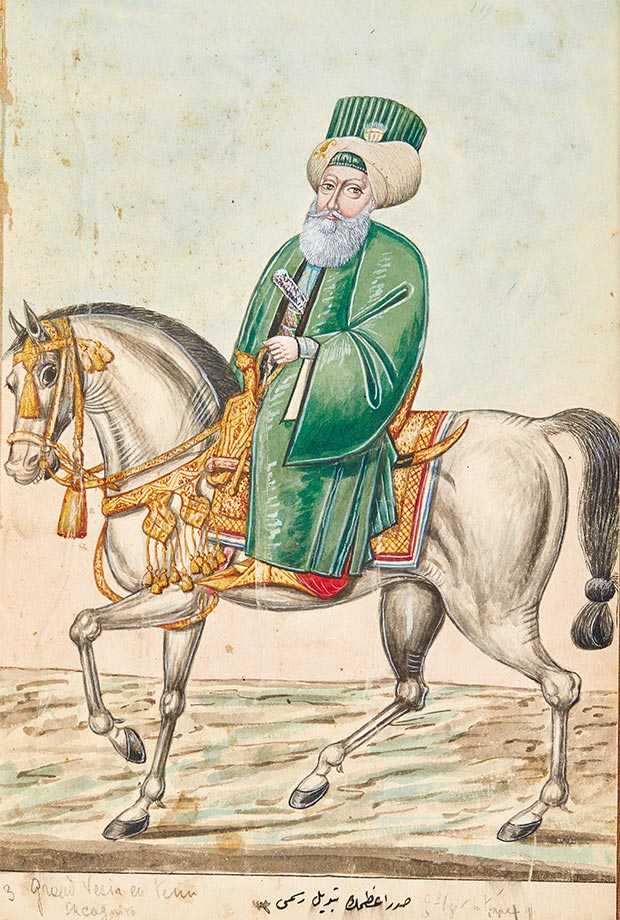 An exceptional costume album attributed to Fenerci Mehmed, Turkey, Ottoman, late 18th - early 19th century / Courtesy of Sotheby's
An exceptional costume album attributed to Fenerci Mehmed, Turkey, Ottoman, late 18th - early 19th century / Courtesy of Sotheby's
Costume albums were books containing characterful portraits of a number of individuals, produced for a foreign diplomatic audience who wished to obtain detailed images of the different costumes worn at the time in Istanbul and had been common in Ottoman culture. This impressive album is thought to have been purchased by a member of the diplomatic entourage in Ottoman Turkey at the end of the nineteenth century, and later acquired by an Ambassador to Iran at the beginning of the twentieth century. It presents a comprehensive catalogue of the costumes of the Topkapi palace in the nineteenth century and the different costumes worn by the military during official ceremonies. Each of the various subjects are numbered and identified in Ottoman Turkish and later in French – a handy guide to identify who was who at the court of the Sultan.
The artist himself was in fact a lantern-maker, and became a painter only after his shop burned down in Fethiye, during the Bayezid fire. Although he painted various subjects and scenes, he was particularly gifted in painting human figures and it is in this milieu that Mehmed made his fortune – his works making it as far as the Ottoman court. Only three other albums painted by the artist are known, one held in the Topkapi Palace and another in the Istanbul University Library.
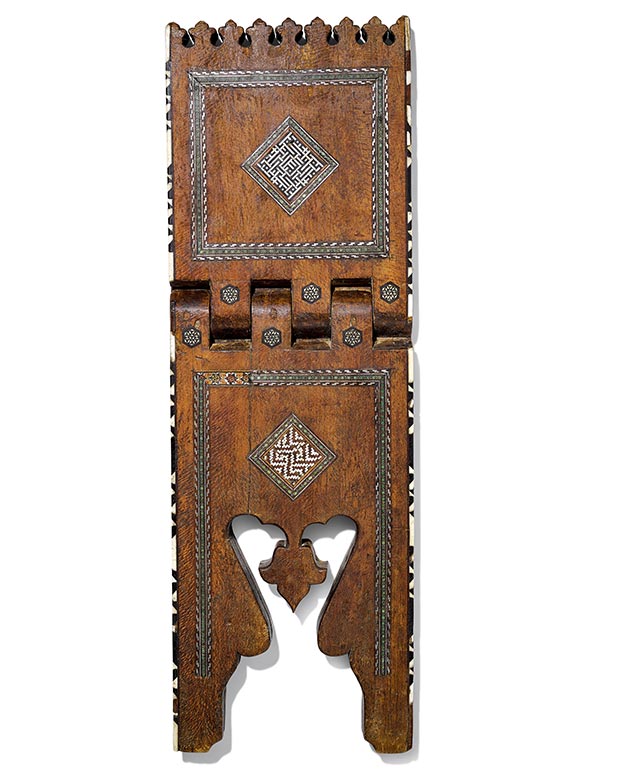 A rare and important Ottoman bone and ivory-inlaid wooden Qur’an stand, Turkey, 15th century / Courtesy of Sotheby's
A rare and important Ottoman bone and ivory-inlaid wooden Qur’an stand, Turkey, 15th century / Courtesy of Sotheby's
Stands such as this were created to hold large, open Qur’ans in mosques and personal collections, and as such are beautifully manufactured. Dated to between 1429 and 1470 AD, this piece is particularly interesting as it displays both Mamluk influences and quintessentially Ottoman designs, lying at the confluence of these periods. It ranks amongst the highest quality of craftsmanship, combining two decorative traditions to create a quintessentially Islamic object from an era of transition and adaptation.
_694-AH_1294-95-AD_2.jpg) Two rare works on astronomy in one volume: Kitab mafatih al-qada ('Keys of Solution'), 1294-95 AD; Abu’l-Hasan Kushyar ibn Labban al-Jabali, Majma’ al-usul fi ahkam al-nujum, Persia, 1295-96 AD / Courtesy of Sotheby's
Two rare works on astronomy in one volume: Kitab mafatih al-qada ('Keys of Solution'), 1294-95 AD; Abu’l-Hasan Kushyar ibn Labban al-Jabali, Majma’ al-usul fi ahkam al-nujum, Persia, 1295-96 AD / Courtesy of Sotheby's
This interesting compendium collates two rare scientific works composed in the ninth century and collated by a scribe at the end of the thirteenth century in Persia. The text includes marginal commentaries and annotations in Greek added in the fourteenth century and later.
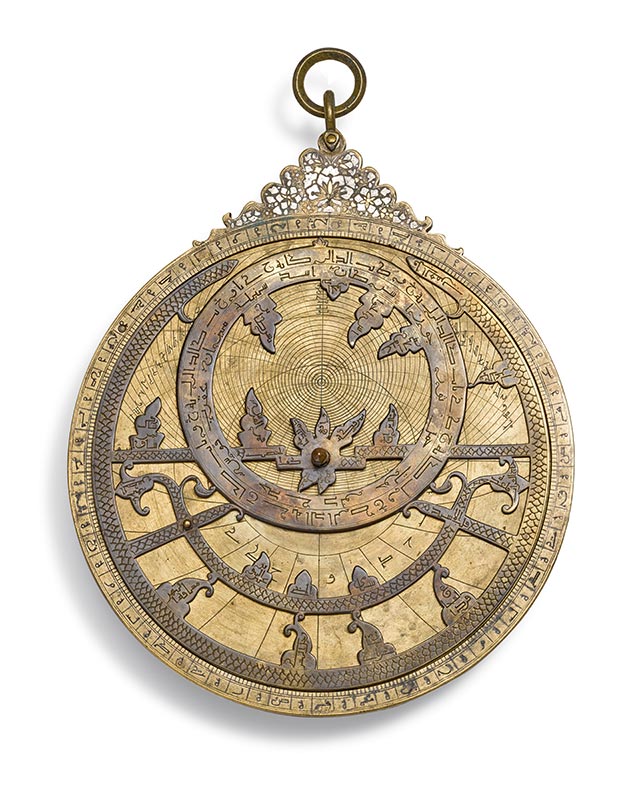 A Mamluk silver and gold-inlaid brass astrolabe, signed by Muhammad ibn Abi Bakr al-Qawwas, Syria, dated 1351-2 AD, with later rete, alidade and three plates, possibly Ottoman period / Courtesy of Sotheby's
A Mamluk silver and gold-inlaid brass astrolabe, signed by Muhammad ibn Abi Bakr al-Qawwas, Syria, dated 1351-2 AD, with later rete, alidade and three plates, possibly Ottoman period / Courtesy of Sotheby's
This highly-decorated fourteenth-century astrolabe was created in Syria, a milieu that was arguably the leading centre of astronomy in the world. Interestingly, the signed maker is unknown to medieval or modern literature.
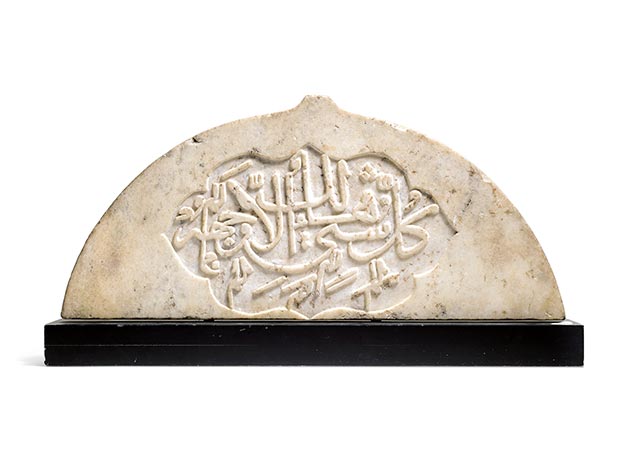 A carved marble calligraphic panel, India, circa 19th century / Courtesy of Sotheby's
A carved marble calligraphic panel, India, circa 19th century / Courtesy of Sotheby's
_signed-by-Muhammad-ibn-Reza,-Persia_Safavid_1017-AH_1608-9-AD.jpg) A Safavid cut-steel standard ('alam), signed by Muhammad ibn Reza, Persia, Safavid, dated 1017 AH, 1608-9 AD, (est. £80,000-120,000) / Courtesy of Sotheby's
A Safavid cut-steel standard ('alam), signed by Muhammad ibn Reza, Persia, Safavid, dated 1017 AH, 1608-9 AD, (est. £80,000-120,000) / Courtesy of Sotheby's
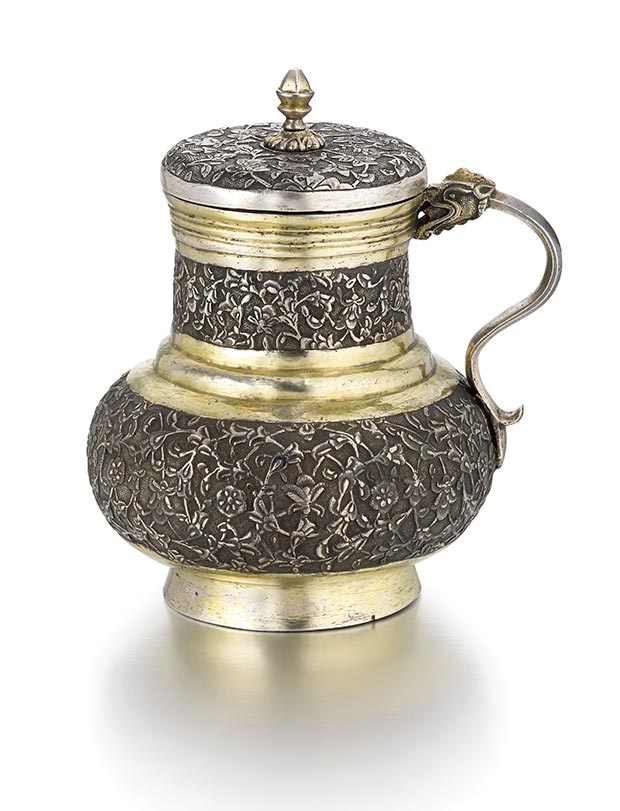 An Ottoman parcel-gilt silver engraved jug, Turkey, circa 1550 / Courtesy of Sotheby's
An Ottoman parcel-gilt silver engraved jug, Turkey, circa 1550 / Courtesy of Sotheby's
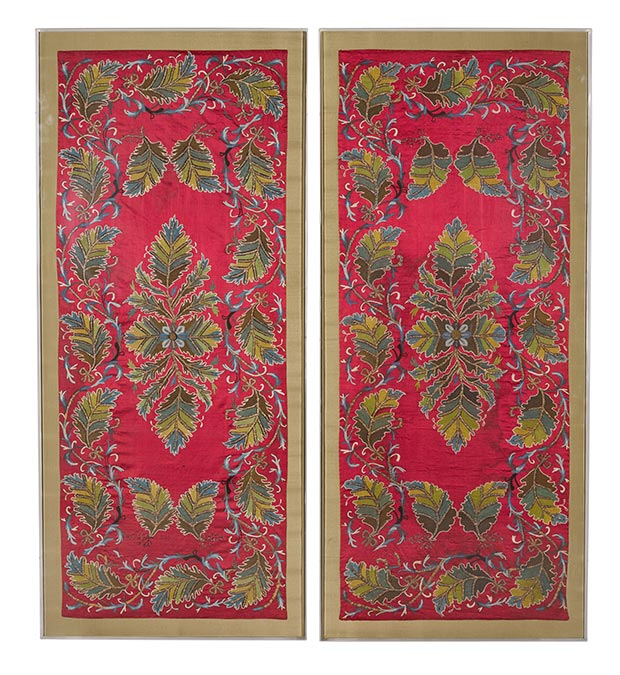 A pair of fine Ottoman embroidered silk panels, Turkey, 18th-19th century / Courtesy of Sotheby's
A pair of fine Ottoman embroidered silk panels, Turkey, 18th-19th century / Courtesy of Sotheby's
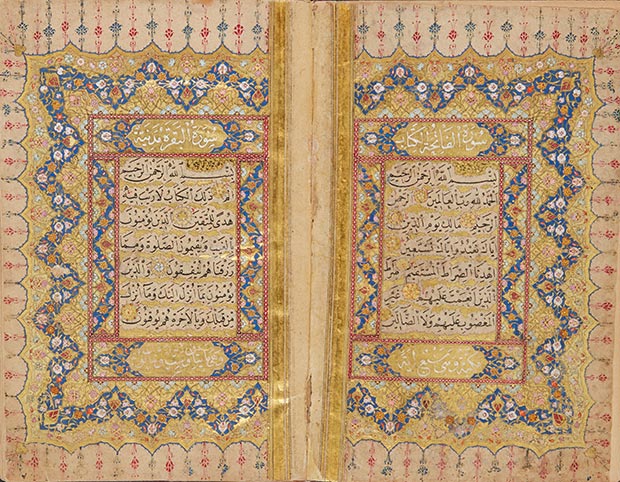 An illuminated Qur'an, copied by Abu Bakr ibn Suleyman, Turkey, Ottoman, dated 1695-96 AD / Courtesy of Sotheby's
An illuminated Qur'an, copied by Abu Bakr ibn Suleyman, Turkey, Ottoman, dated 1695-96 AD / Courtesy of Sotheby's
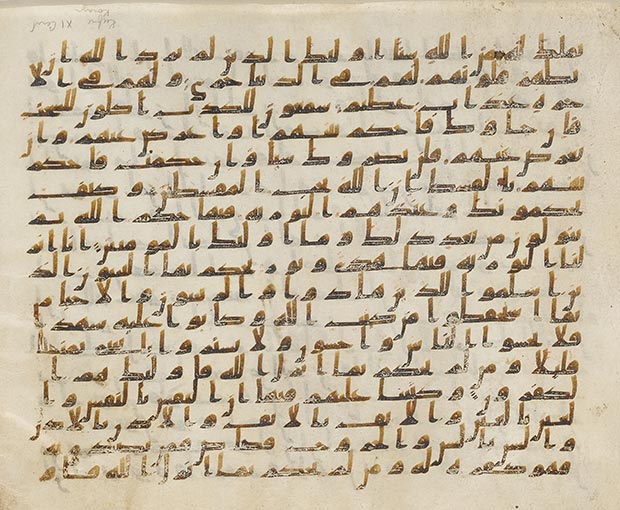 A Qur'an lead in Kufic on vellum, Near East, 8th century AD, 28.2 by 36.6cm / Courtesy of Sotheby's
A Qur'an lead in Kufic on vellum, Near East, 8th century AD, 28.2 by 36.6cm / Courtesy of Sotheby's
Born in New York to Russian immigrant parents, Hellen Solomon Darion studied the violin and modern dance. She married Joe Darion, an American lyricist best known for writing the lyrics for the long-running musical ‘Man of La Mancha’. Sharing a love of the arts, the couple had eclectic collecting taste and travelled the world with a tireless appetite for learning. The Persian and Indian paintings in their outstanding collection span a period of around three hundred years, with examples of manuscript illustration from Safavid Persia, lyrical scenes from Mughal India and the Deccan, and examples of Hindu painting from the Pahari Hills of North India
 Akbar enthroned with courtiers under a canopy, possibly a previously unknown illustration from the 'British Library/Chester Beatty' Akbarnama of 1602-03, India, Mughal, early 17th century / Courtesy of Sotheby's
Akbar enthroned with courtiers under a canopy, possibly a previously unknown illustration from the 'British Library/Chester Beatty' Akbarnama of 1602-03, India, Mughal, early 17th century / Courtesy of Sotheby's
This finely executed Mughal drawing of Emperor Akbar receiving courtiers may be an important and previously unknown illustration from the so-called 'British Library/Chester Beatty' Akbarnama, executed around 1602 to 1603 and now divided mostly between the institutions. A notable aspect is the fact that Akbar is sitting on a European style chair. Chairs of this type began to appear in Mughal painting in the 1570s, derived from European prints brought to India by the Portuguese, with whom Akbar first had contact in 1573.
 An illustrated and illuminated leaf from a manuscript of Firdausi's Shahnameh Rustam shoots Afrasiyab in the eye, Persia, Safavid, 16th century / Courtesy of Sotheby's
An illustrated and illuminated leaf from a manuscript of Firdausi's Shahnameh Rustam shoots Afrasiyab in the eye, Persia, Safavid, 16th century / Courtesy of Sotheby's
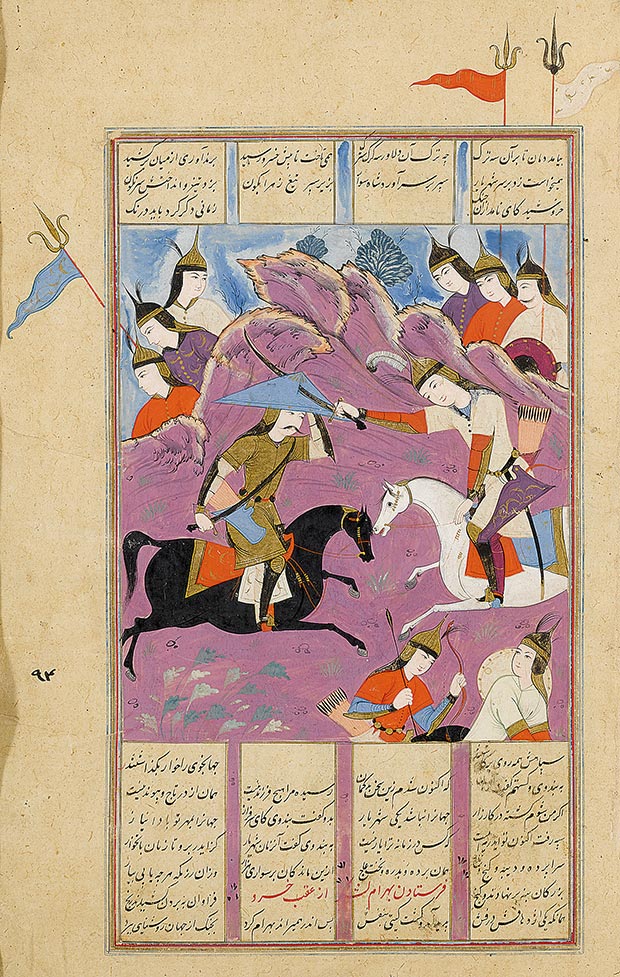 An illustrated and illuminated leaf from a manuscript of Firdausi's Shahnameh: Bahram-e Chubineh attacks Khusraw Parviz’s army at night, signed by Mu'in Mussavir, Persia, Safavid, 17th century / Courtesy of Sotheby's
An illustrated and illuminated leaf from a manuscript of Firdausi's Shahnameh: Bahram-e Chubineh attacks Khusraw Parviz’s army at night, signed by Mu'in Mussavir, Persia, Safavid, 17th century / Courtesy of Sotheby's
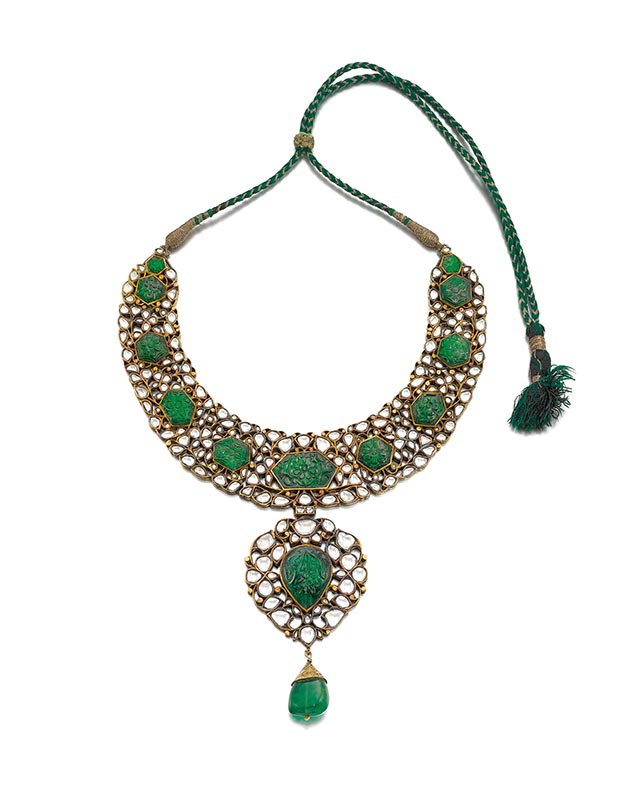 A diamond and emerald-set enamelled necklace, North India, late 19th century / Courtesy of Sotheby's
A diamond and emerald-set enamelled necklace, North India, late 19th century / Courtesy of Sotheby's
_North-India_late-18th-19th-century.jpg) A gem-set and enamelled turban ornament (jigha or sarpech), North India, late 18th - 19th century / Courtesy of Sotheby's
A gem-set and enamelled turban ornament (jigha or sarpech), North India, late 18th - 19th century / Courtesy of Sotheby's
 A large white sapphire and enamelled necklace, North India, circa 1900 / Courtesy of Sotheby's
A large white sapphire and enamelled necklace, North India, circa 1900 / Courtesy of Sotheby's
Comments
Add a comment